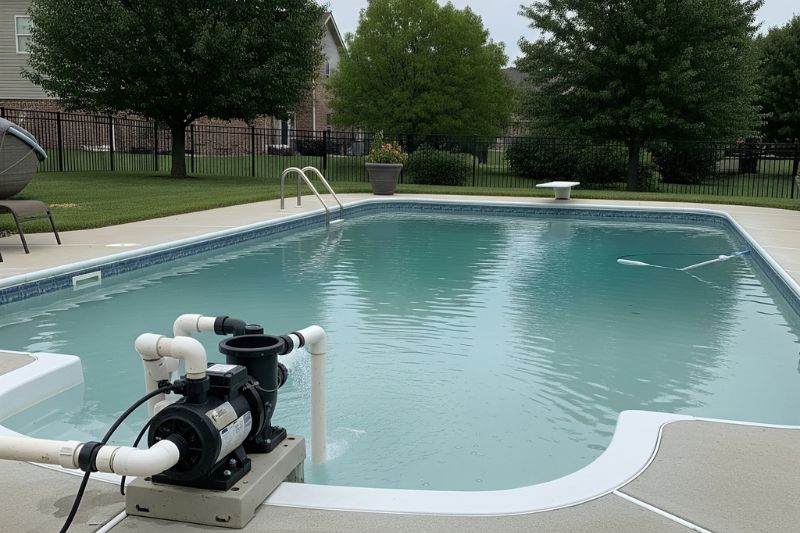
Why Is My Pool Pump Losing Suction?
Share
Check for clogged skimmer baskets, dirty filters, or air leaks in the pump system, and clean or repair as needed.
How Pool Pump Suction Works
Your pool pump draws water through the skimmer and main drain, then pushes it through the filter and returns it to the pool. Good suction keeps water circulating, filters debris, and distributes chemicals. When suction drops, your system can't do its job and water can turn cloudy fast.
In normal operation, the skimmer and drain pull in water, which the pump moves through the filter and returns to the pool via jets. Even a minor interruption can throw the entire system off.
Signs Your Pump Is Losing Suction
You don’t need to be a technician to notice something’s wrong. Weak return flow, gurgling noises, or bubbles in the system are all signs. If your water isn't circulating, the pressure gauge is reading low, or there's visible debris floating longer than usual, it's time to investigate suction loss.
Common Reasons a Pool Pump Loses Suction
Air Leaks in the Suction Line
Air leaks around the pump lid, unions, or pipe fittings are one of the most common causes of suction loss.
-
Check the pump lid O-ring for cracks or flattening.
-
Lubricate the O-ring with silicone-based lube.
-
Tighten any unions or fittings that appear loose.
-
Look for bubbles in the pump basket while the system is running.
Clogged Skimmer or Pump Basket
Debris buildup in either basket restricts water flow. It’s easy to overlook, especially during high-debris seasons.
-
Empty the skimmer basket regularly.
-
Clean out the pump basket at least once a week.
-
Inspect after wind, storms, or heavy pool use.
Dirty or Full Filter
A filter that hasn’t been cleaned will increase backpressure and reduce flow to the point that suction drops.
-
Backwash sand or DE filters when pressure rises 8–10 psi above normal.
-
Rinse cartridge filters and replace if damaged.
-
Schedule monthly cleanings during peak season.
Low Pool Water Level
When the water dips below the skimmer opening, air gets pulled into the line.
-
Water should always sit halfway up the skimmer face.
-
Refill with a hose and check levels weekly.
Blocked Suction Line
Leaves and small debris can clog the plumbing, especially if the baskets weren’t cleaned regularly.
-
Use valve controls to isolate suction lines and identify reduced flow.
-
A plumbing snake or drain bladder can help clear minor blockages.
Failing Pump Lid O-Ring
O-rings are small but critical. If brittle or misaligned, they compromise the seal and let air in.
-
Replace annually or if any cracks are visible.
-
Keep it lubricated and seated correctly.
Clogged or Damaged Impeller
An impeller that’s jammed by hair, leaves, or dirt won’t move water efficiently.
-
Shut off the power and open the pump housing.
-
Use a screwdriver to gently clear debris.
-
Spin the impeller to check for damage or resistance.
How to Troubleshoot and Restore Suction
Begin with the basics. Turn off the pump and clean both the skimmer and pump baskets. Prime the pump by filling the housing with water before sealing the lid.
Restart the system and check for strong, steady return flow. Watch for air bubbles inside the pump window. If present, test for leaks using soapy water on fittings. Bubbles forming at joints indicate an air leak.
If flow is still weak, backwash or rinse the filter. Persistent issues could mean a deeper blockage or an impeller problem.
Tips to Prevent Suction Issues Long-Term
Consistency is key. Make small maintenance tasks part of your weekly pool care routine:
-
Keep the water level steady to avoid drawing in air.
-
Clean all baskets weekly, or more often if conditions demand.
-
Check and lubricate the pump lid O-ring every month.
-
Inspect return flow strength and water clarity regularly.
Trim trees around the pool to limit leaf and debris load. Consider using a skimmer sock to trap fine particles that might otherwise make their way to the pump.
Schedule a professional equipment check at least once a year. A technician can spot developing issues like worn seals, motor inefficiencies, or plumbing cracks before they become major problems.
Learn Your System and Stay Proactive
Suction loss in your pool pump is often avoidable with routine inspections and a little know-how. The sooner you catch the symptoms, the easier it is to fix. Understanding your pump, filter, and circulation system puts you in control and helps keep your pool water clean, balanced, and ready for swimming.

1 comment
Never thought I’d be this invested in pool equipment, but here we are. I had no idea something as small as an air leak or clogged basket could mess up suction so much. This guide really helped me understand how to fix low suction in a pool pump without calling someone in. Super helpful for newbies like me!